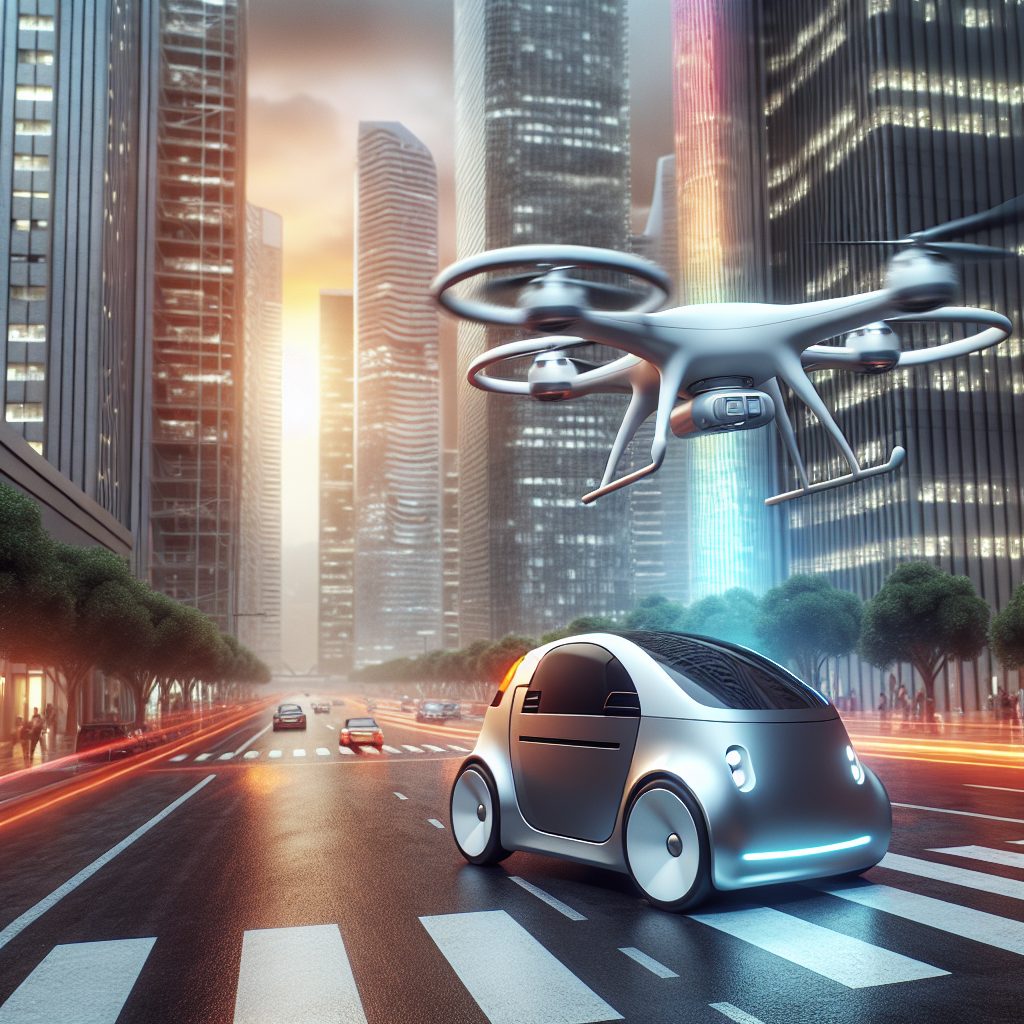In an era where technology zooms past us at warp speed, the buzz around drones and autonomous vehicles is louder than ever. Investors are eyeing these sectors like hawks, knowing full well that they’re not just gadgets from a sci-fi flick—they’re the future of transport and logistics. This piece will navigate through the complexities of pouring capital into these cutting-edge industries. You’ll get the inside scoop on strategies for smart investments and learn how these innovations could reshape our world.
Buckle up, as we take a deep dive into the realm of unmanned aerial vehicles and self-driving cars. The landscape is teeming with potential, but it’s not for the faint-hearted. With regulations still in the making and technology advancing by the day, you’ve got to stay sharp. We’ll explore what makes these markets tick, uncover investment hotspots, and reveal how to steer clear of turbulence. Get ready to discover how you can be part of this high-flying journey toward a truly autonomous tomorrow.
Important Highlights
1. Investor interest in drones and autonomous vehicles has surged due to their potential to revolutionize industries such as delivery services, agriculture, and transportation. These technologies promise to enhance efficiency, reduce costs, and improve safety, which are driving factors for businesses looking to stay competitive in a rapidly evolving market.
2. The regulatory landscape is a significant factor influencing the adoption of drones and autonomous vehicles. Governments worldwide are grappling with creating frameworks that ensure public safety without stifling innovation. Investors must navigate these regulations carefully, as they can impact the speed at which these technologies can be deployed and scaled.
3. Advancements in artificial intelligence (AI) and machine learning are critical to the development of drones and autonomous vehicles. These systems rely heavily on AI to interpret data from their sensors and make decisions in real time. As AI technology progresses, so too does the capability of these autonomous systems to operate more effectively and handle complex tasks.
4. There’s a growing emphasis on sustainability, with many companies investing in electric-powered drones and vehicles to reduce carbon emissions. This shift not only aligns with global environmental goals but also resonates with consumer preferences towards eco-friendly practices, potentially increasing market adoption rates.
5. Strategic partnerships between tech companies, automotive manufacturers, and logistics providers are pivotal in propelling the drone and autonomous vehicle sector forward. By pooling resources and expertise, these collaborations are accelerating technological breakthroughs and creating robust solutions that address current technical limitations, such as battery life and sensor accuracy.
For further insights into regulatory aspects affecting this industry, you might explore the resources available on the website of the Federal Aviation Administration (FAA), which provides extensive guidelines on drone operations within the United States.
Market Growth and Investment Trends in Drone Technology
The drone industry is experiencing rapid expansion, with investment opportunities blossoming in various sectors. As Goldman Sachs reports, commercial and civil government applications are fueling this growth. Drone technology has leaped forward, offering solutions for aerial photography, surveying, logistics, and even agriculture. Investors are particularly keen on startups that promise innovative applications such as delivery systems and traffic management tools.
In terms of market trends, we’re seeing a surge in venture capital flowing into drone startups. Companies like DJI continue to dominate the consumer market, yet there’s an increasing number of players focusing on specialized commercial functions. These entities are not just manufacturing drones but also developing sophisticated software for data analysis and fleet management.
Regulatory Landscape Shaping Drone Investments
The regulatory environment plays a crucial role in shaping drone investments. Organizations like the Federal Aviation Administration (FAA) in the United States set guidelines that affect how drones can be used commercially. They have been rolling out rules that streamline operations while ensuring safety and privacy. As regulations become more defined, they pave the way for increased commercial use cases, offering clarity to investors about the potential scalability of drone-based businesses.
It’s essential for investors to stay abreast of these regulations since they can significantly impact the viability of drone operations across different industries. For instance, beyond visual line of sight (BVLOS) operations could revolutionize delivery services if given the green light by aviation authorities.
Emerging Technologies in Autonomous Vehicles
The realm of autonomous vehicles (AVs), including cars, trucks, and unmanned ground vehicles, presents another exciting frontier for investors. Advances in machine learning algorithms and sensor technologies are driving progress in this sector. Tech giants like Tesla are at the forefront with their autopilot features while traditional automotive manufacturers are rapidly catching up.
Innovations such as LiDAR sensors, which enable AVs to perceive their surroundings with incredible accuracy, have become less expensive and more accessible. This democratization of technology allows startups to experiment with autonomous systems without prohibitive costs, encouraging diverse applications from ride-sharing to long-haul trucking.
Strategic Partnerships Between Tech Companies and Automakers
A key strategy that is proving beneficial for both tech companies and traditional automakers is forming strategic partnerships. Collaborations between Silicon Valley innovators and established vehicle manufacturers combine technological prowess with manufacturing expertise. These unions help accelerate the deployment of AVs by integrating cutting-edge software with reliable hardware at scale.
An example is the partnership between Google’s Waymo and Fiat Chrysler, which combines Waymo’s self-driving technology with Chrysler’s minivans to roll out autonomous ride-hailing services.
Risks and Challenges in AV Investment
Investing in autonomous vehicles carries its own set of risks and challenges. The high cost of research and development can be daunting, while uncertainty around consumer acceptance remains a concern. Additionally, cybersecurity poses a significant threat; thus investment in robust security measures is paramount to protect against potential breaches that could compromise safety.
Moreover, as AV technology advances towards higher levels of autonomy, liability in case of accidents becomes a complex issue that requires careful consideration by investors regarding insurance implications and ethical considerations.
Economic Impact and Societal Benefits
The economic impact of wide-scale adoption of drones and autonomous vehicles promises to be substantial. Efficiency gains in logistics could lead to reduced transportation costs while enhancing speed and reliability of service delivery. Furthermore, autonomous vehicles hold the potential to drastically reduce accident rates caused by human error, leading to safer roads.
Societal benefits also extend to improved mobility for those who cannot drive due to disabilities or age-related factors—thus opening new avenues for inclusive transportation solutions.
Sustainability Considerations
Sustainability is becoming increasingly important in investment decisions within the drone and autonomous vehicle sectors. Electric-powered drones contribute to reducing carbon emissions compared to traditional delivery methods. Similarly, electric autonomous vehicles present an opportunity to decrease pollution levels caused by conventional combustion engines.
Clean energy initiatives complement these technologies well; hence investors often look for companies that align with environmental sustainability goals when considering where to allocate funds within this new frontier.
How Do You Ensure a Smart Investment Strategy?
- Meticulously assess regulatory changes that may affect drone operation legality or autonomous vehicle deployment opportunities.
- Analyze partnerships between tech firms and automakers for strong indicators of sustainable business models in AV development.
- Weigh risks associated with cybersecurity threats alongside R&D costs when evaluating investment options.
- Evaluate potential economic benefits against societal impacts—prioritizing companies that offer innovative solutions addressing both profitability and inclusivity concerns.
- Factor in sustainability practices as part of your investment criteria—favoring clean tech innovations within these sectors over less environmentally conscious alternatives.
How Do Investments in Robotics and Automation Impact the Drone and Autonomous Vehicle Industry?
The integration of robotics and automation is revolutionizing the drone and autonomous vehicle industry. By exploring innovations in robotics and automation, companies can enhance efficiency, reduce costs, and improve safety. These advancements are not only streamlining production but also enabling more sophisticated operational capabilities in real-world applications.
Frequently Asked Questions
What are the potential benefits of investing in drones?
Drones offer a wide range of applications, from delivering goods to capturing aerial footage, which can lead to significant advancements in efficiency and cost reduction for businesses. They also open up new markets and services that were previously unattainable or too expensive.
Can autonomous vehicles really improve road safety?
Yes, autonomous vehicles have the potential to reduce accidents caused by human error through advanced sensors and AI decision-making. They are designed to obey traffic laws consistently and react quickly to avoid collisions.
How do drones and autonomous vehicles impact the environment?
These technologies could lead to a greener future by optimizing routes for energy efficiency, reducing the need for traditional transportation, and potentially lowering emissions with electric-powered models.
What are the biggest challenges facing drone and AV investment?
The main hurdles include regulatory compliance, public acceptance, technological reliability, and cybersecurity concerns. Overcoming these challenges is critical for widespread adoption.
Are there any privacy concerns associated with drones?
Certainly. Drones equipped with cameras can raise privacy issues due to their ability to capture images in private spaces. It’s vital that regulations safeguard personal privacy rights.
How will jobs be affected by these technologies?
While some fear job loss due to automation, these innovations also create new roles in technology development, maintenance, and operation management. The job landscape will shift rather than diminish.
Is the infrastructure ready for autonomous vehicles?
Not entirely. Significant investments in road systems, communication networks, and charging stations are necessary to support a widespread transition to autonomous transportation.
What should investors know about the market readiness of these technologies?
Investors should understand that market readiness varies greatly across different regions and sectors. Early-stage investments may carry more risk but also offer greater long-term rewards as the technology matures.
How can one stay updated on advancements in this field?
To remain informed, follow industry news, attend tech conferences, engage with expert communities online, and subscribe to journals specializing in drone and autonomous vehicle technologies.
What kind of return on investment (ROI) can be expected from drones and AVs?
The ROI depends on various factors like technological progress, market adoption rates, regulatory changes, and competitive dynamics. While precise predictions are challenging, many see substantial growth potential in these sectors.
In Summary: The Road Ahead
In conclusion, venturing into the realm of drones and autonomous vehicles presents an exciting opportunity for forward-thinking investors. Despite challenges such as regulatory landscapes and technological hurdles, the positive impact on commerce, safety, and environmental sustainability paints a promising picture for those willing to navigate these new frontiers.
The journey requires vigilance regarding evolving standards and societal implications but holds the promise of reshaping our world dramatically. For those who invest wisely and adaptively in these burgeoning fields, the horizon brims with potential just waiting to be unlocked.

